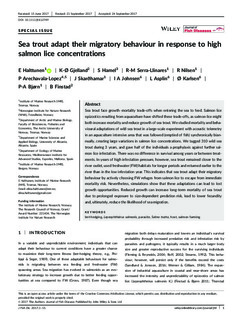| dc.contributor.author | Halttunen, Elina | |
| dc.contributor.author | Gjelland, Karl Øystein | |
| dc.contributor.author | Hamel, Sandra | |
| dc.contributor.author | Serra-Llinares, Rosa Maria | |
| dc.contributor.author | Nilsen, Rune | |
| dc.contributor.author | Arechavala-Lopez, Pablo | |
| dc.contributor.author | Skardhamar, Jofrid | |
| dc.contributor.author | Johnsen, Ingrid Askeland | |
| dc.contributor.author | Asplin, Lars | |
| dc.contributor.author | Karlsen, Ørjan | |
| dc.contributor.author | Bjørn, Pål Arne | |
| dc.contributor.author | Finstad, Bengt | |
| dc.date.accessioned | 2018-01-12T14:21:46Z | |
| dc.date.available | 2018-01-12T14:21:46Z | |
| dc.date.created | 2018-01-10T11:27:21Z | |
| dc.date.issued | 2017 | |
| dc.identifier.citation | Journal of Fish Diseases. 2017, 1-15. | |
| dc.identifier.issn | 0140-7775 | |
| dc.identifier.uri | http://hdl.handle.net/11250/2477307 | |
| dc.description.abstract | Sea trout face growth – mortality trade-offs when entering the sea to feed. Salmon lice epizootics resulting from aquaculture have shifted these trade-offs, as salmon lice might both increase mortality and reduce growth of sea trout. We studied mortality and beha- vioural adaptations of wild sea trout in a large-scale experiment with acoustic telemetry in an aquaculture intensive area that was fallowed (emptied of fish) synchronically bian- nually, creating large variations in salmon lice concentrations. We tagged 310 wild sea trout during 3 years, and gave half of the individuals a prophylaxis against further sal- mon lice infestation. There was no difference in survival among years or between treat- ments. In years of high infestation pressure, however, sea trout remained closer to the river outlet, used freshwater (FW) habitats for longer periods and returned earlier to the river than in the low infestation year. This indicates that sea trout adapt their migratory behaviour by actively choosing FW refuges from salmon lice to escape from immediate mortality risk. Nevertheless, simulations show that these adaptations can lead to lost growth opportunities. Reduced growth can increase long-term mortality of sea trout due to prolonged exposure to size-dependent predation risk, lead to lower fecundity and, ultimately, reduce the likelihood of sea migration | |
| dc.language.iso | eng | |
| dc.title | Sea trout adapt their migratory behaviour in response to high salmon lice concentrations | |
| dc.type | Peer reviewed | |
| dc.type | Journal article | |
| dc.description.version | publishedVersion | |
| dc.source.pagenumber | 1-15 | |
| dc.source.journal | Journal of Fish Diseases | |
| dc.identifier.doi | 10.1111/jfd.12749 | |
| dc.identifier.cristin | 1539635 | |
| dc.relation.project | Norges forskningsråd: 221404 | |
| dc.relation.project | Havforskningsinstituttet: Prosjektfinansiering | |
| dc.relation.project | Norsk institutt for naturforskning: Prosjektfinansiering | |
| cristin.unitcode | 7431,17,0,0 | |
| cristin.unitcode | 7431,0,0,0 | |
| cristin.unitcode | 7431,20,0,0 | |
| cristin.unitcode | 7431,24,0,0 | |
| cristin.unitname | Sykdom og smittespredning | |
| cristin.unitname | Havforskningsinstituttet | |
| cristin.unitname | Oseanografi og klima | |
| cristin.unitname | Reproduksjon og utvikl.biologi | |
| cristin.ispublished | true | |
| cristin.fulltext | original | |
| cristin.qualitycode | 2 | |
